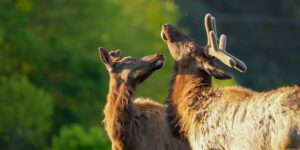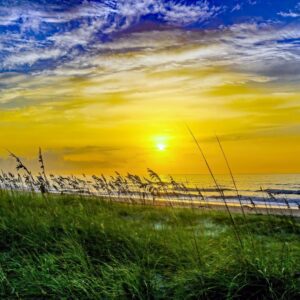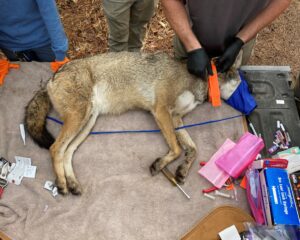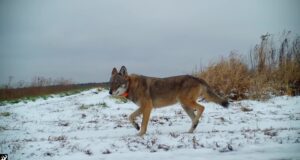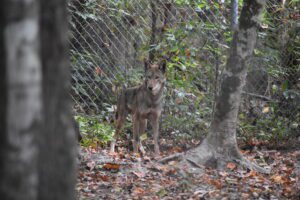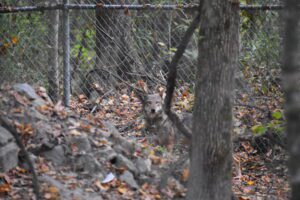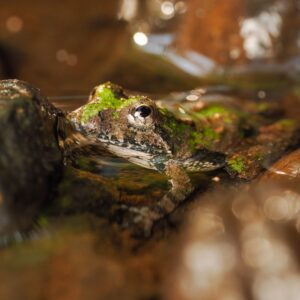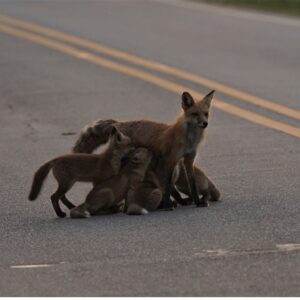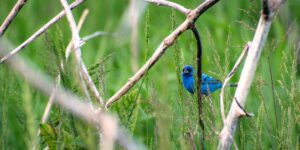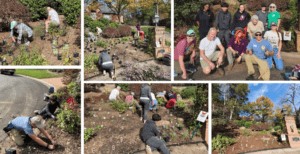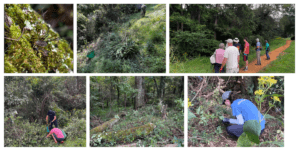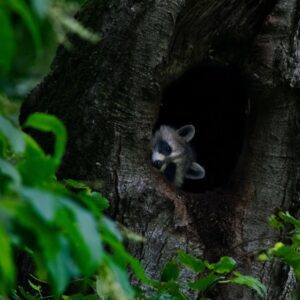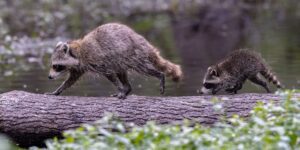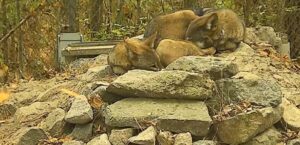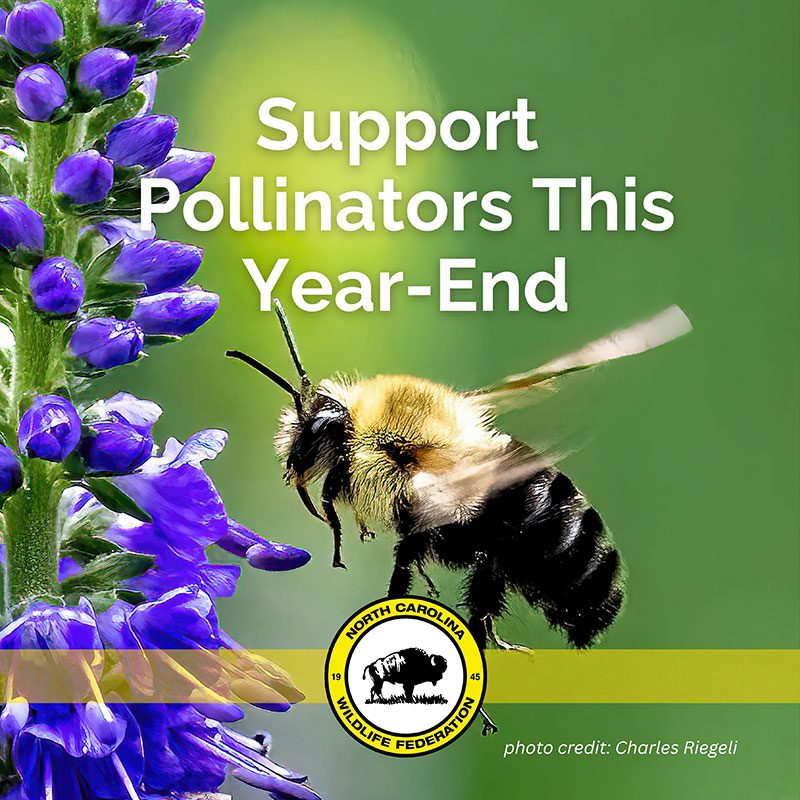The State of Our Wildlife – 2024 Year In Review
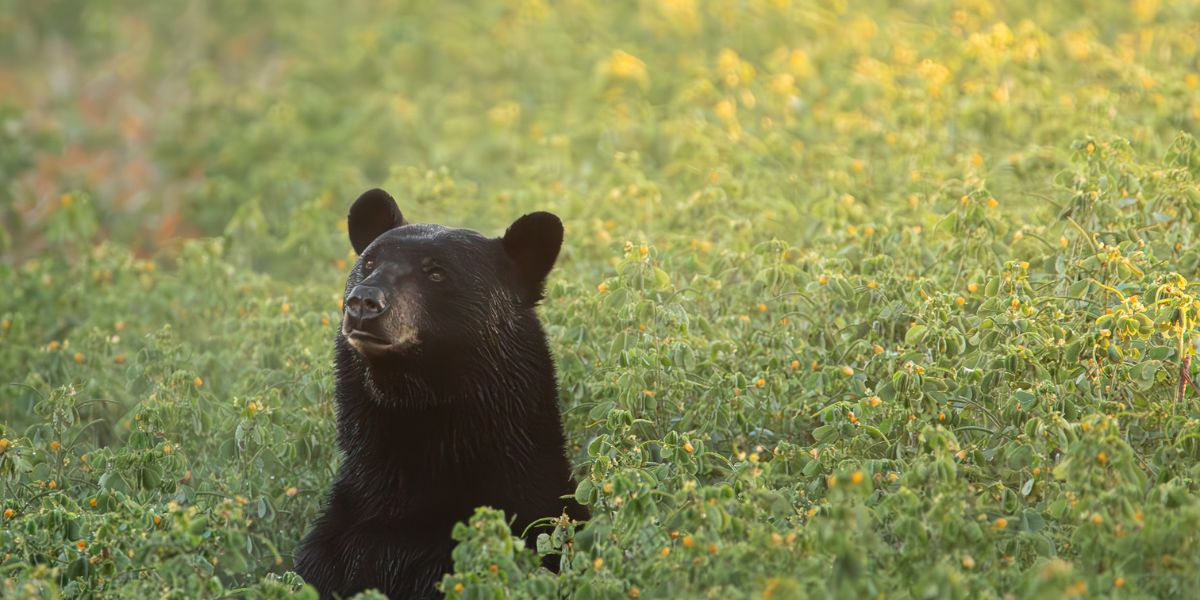
“When I consider that the nobler animals have been exterminated here – the cougar, the panther, lynx, wolverine, wolf, bear, moose, deer, the beaver, the turkey and so forth, I cannot but feel as if I lived in a tamed country… Is it not a maimed and imperfect nature I am conversing with?… I take infinite pains to know all the phenomena of the spring, for instance, thinking that I have here the entire poem, and then, to my chagrin, I hear that it is but an imperfect copy that I possess and have read, that my ancestors have torn out many of the first leaves and grandest passages, and mutilated it in many places. I should not like to think that some demigod had come before me and picked out some of the best of the stars. I wish to know an entire heaven and an entire earth.” – Henry David Thoreau, The Journal, 1837-1861
How do we reckon with the observation noted by Charles Darwin’s collaborator Alfred Russell Wallace, that we live in a “zoologically impoverished world”—one that lacks fully intact ecosystems? The recognition that ecological impoverishment stems mainly from the damage inflicted on ecological relationships is a sentiment that Aldo Leopold likens to “living alone in a world of wounds.”
At first glance, this paints a bleak picture – one that often feels impossible to address in any meaningful or practical way. How can we hope to restore an entire natural world featuring many species of wildlife that are teetering on the edge of extinction? How can we return our ecosystems to their former state and recapture an idealized vision of nature as it once was? The truth: it’s likely we can’t.
Rapid development continues to surge relentlessly across the state, country, and planet, with little indication of large-scale remediation. Pollution runs unchecked, not only in urban areas but also in remote landscapes, in our air, in our water, and even in our own bodies—fueled by the growing severity of catastrophic events like Hurricane Helene which wreaked havoc on the Western region of our state, depositing tons of detritus in waterways and destroying yet still unknown amounts of infrastructure and natural ecosystems. Wildlife habitats are increasingly fragmented, and invasive species continue to spread despite our best efforts to eradicate them from native ecological communities. How can we possibly aspire to understand and bring to realization, as Thoreau emphasizes, “an entire heaven and an entire earth”?
In his book Wild New World, anthropologist and conservationist Dan Flores, drawing directly from Thoreau, proposes: “The prescription I’ve come to seems to be this. Know the heaven and earth that was, but experience the world that is.” At North Carolina Wildlife Federation (NCWF), this has been our approach, both this year and since our founding in 1945. Common sense conservation supported by science requires a realistic, present-focused perspective on both natural and human-made environments, and the interconnectedness between them. We cannot—and should not—try to recreate an idealized version of the landscape from before our time. Instead, we must assess where we stand now and honestly consider how we can improve it, for both wildlife and people.
This involves confronting the challenges posed by rapid development and urban sprawl, opposing policies that threaten wildlife and the communities that value them, advocating for wildlife-friendly practices, and supporting leaders who can champion these causes in the political arena. It also means mobilizing our community of conservation in North Carolina to do meaningful work in their own communities.
This is the world of the bobwhite quail, of the brook trout, of the black bear, of the St. Francis satyr, of the osprey, of the red drum, of the white-tailed deer… and it’s our world, too. For the benefit of all life that exists with us in this state, we must take responsibility for the “heaven and earth” that exists here and now. This year, NCWF and the broader conservation community in North Carolina made significant progress in protecting, conserving, and restoring wildlife and habitats throughout the state. The fight continues, and the mission remains urgent, and we hear it loud and clear – voiced in the bugle of the Smoky Mountain elk, the howl of the Red Wolf, the call of the great horned owl, and the voices of those determined to ensure their survival.
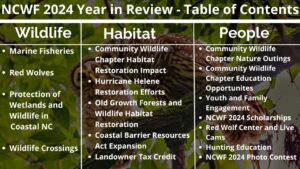
Wildlife
“Conservation is a state of harmony between men and land. Harmony with land is like harmony with a friend; you cannot cherish his right hand and chop off his left. That is to say, you cannot love game and hate predators; you cannot conserve the waters and waste the ranges; you cannot build the forest and mine the farm. The land is one organism. Its parts, like our own parts, compete with each other and cooperate with each other. The competitions are as much a part of the inner workings as the cooperations. You can regulate them- cautiously- but not abolish them.” – Aldo Leopold, A Sand County Almanac
Conservation requires careful thought, long-term commitment, and a comprehensive understanding of both the living and nonliving components of ecosystems. To protect, conserve, and restore wildlife in North Carolina and beyond, we must approach it as one would a friendship—constantly learning, caring for their wellbeing, shielding them from harm, and defending them in times of need.
For nearly 80 years, NCWF has been a steadfast advocate for such an approach. In 2024, we continued our mission to be the leading voice for wildlife in North Carolina through our commitment to common sense conservation, supported by science.
-
Marine Fisheries
In North Carolina, the practice of large-scale inshore shrimp trawling continues, making the state the only one on the Atlantic and Gulf coasts to allow this destructive, unsustainable fishing method. Bottom trawling, which involves dragging heavy chains and nets across fragile underwater landscapes, devastates the sounds, estuaries, and fish populations. For every pound of shrimp harvested, over four pounds of bycatch—juvenile finfish and other marine life—are discarded, killing an estimated 700 million non-target animals annually. Inshore trawling also accounts for tens of millions of pounds of dead marine life each year, significantly reducing key species like grey trout, spot, croaker, and blue crab, threatening the health and sustainability of these vital ecosystems.
Simultaneously, NCWF’s work continues in addressing this destructive practice, and seeking reform that is in the best interest of wildlife, fisheries, and people, alike. For NCWF, the protection of public trust resources — including as coastal fisheries — has been a longstanding priority.
Save Our Sounds
Dr. Louis Daniel, NCWF Senior Marine Scientist, drafted several letters addressing southern flounder and spotted seatrout management plans to the North Carolina Marine Fisheries Commission (MFC). These letters raised concerns about the inadequacy of stock assessments, the failure to account for fishing mortality, and the lack of sufficient management measures to rebuild these important fisheries.
NCWF also continues to work on the issue of shrimp otter trawl fisheries and their impact on important fish species. These efforts focus on moving the North Carolina shrimp otter trawl fishery out of estuarine nursery grounds and into the Atlantic Ocean. These efforts will continue in 2025, alongside the ongoing lawsuit filed by the Coastal Conservation Association.
Note on Marine Fisheries Lawsuit
In 2020, a civil action lawsuit was filed against the State of North Carolina, by citizens and Coastal Conservation Association, asserting the State has not met its legal duties to protect harvestable fish populations for the benefit of all North Carolina citizens. The suit was brought after decades of declining fish stocks, and the failure of State actors to take aggressive enough actions to reverse those declines. Protection of public trust resources, including restoration of coastal fisheries, has long been a top Federation priority, thus NCWF filed an amicus brief with the North Carolina Court of Appeals focused on failures by the State to protect public trust resources, our marine fisheries, appropriately.
In 2022, the North Carolina Court of Appeals entered an important opinion. The court noted the constitutional right to harvest fish would be rendered meaningless without citizen access to fish. According to the Court of Appeals opinion, the State has an obligation “to preserve the people’s right to fish and harvest fish.” This includes a “duty to preserve fisheries for the benefit of the public” and a “duty to keep fisheries safe from injury, harm, or destruction for all time.” The court rejected the State’s defense that it enjoyed immunity from any suit over its management of fisheries and remanded the case for pretrial discovery.
According to Manley Fuller, NCWF’s VP conservation policy this was an important step in the case which NCWF celebrated with the plaintiffs.
“North Carolina’s public trust doctrine protects trust lands, waters and resources, including fisheries and wildlife. If citizens can’t use the courts to ensure the State meets its stewardship obligations for these public resources, our keystone legal component of fish and wildlife conservation becomes meaningless,” Fuller said. “Trying to hold the State accountable for mismanaging our marine fisheries has been a long journey, so we’re happy the appeals are over and this important case can finally move forward in the courts.”
During this years’ phase of pre trial discovery, NCWF’s Senior Marine Scientist drafted an expert opinion report in support of the lawsuit and was deposed, along with another NCWF staffer, in September 2024 by the State’s attorneys. The expert opinion report provided the technical basis for our long-founded concerns that the State is improperly managing our marine fisheries resources by failing to use best scientific principles, ignoring the precautionary approach to fisheries management, and erring on the side of a minority economic impact versus the majority public trust. “A healthy, estuarine ecosystem benefits all North Carolina citizens. NCWF is fully committed to promoting and achieving substantive changes in the management of our public trust marine resources”, stated Dr. Louis Daniel NCWF senior marine scientist. “Our Sound Solutions campaign relies on sound science and best management practices to rebuild our devastated, state managed fisheries”.
Mediation is scheduled for February 2025, and the trial in the liability phase of the case is scheduled to begin in April 2025. NCWF will be a key stakeholder in the continuing phases of the lawsuit process to defend public trust resources.
Red Wolves
Red Wolves once roamed the eastern seaboard, stretching from Pennsylvania to Florida and as far west as Texas. Today, they are the world’s most endangered canid, with the only remaining population in the wild found in Northeastern North Carolina.
NCWF has been a longstanding partner of the U.S. Fish and Wildlife Service and other local organizations in efforts to recover the Red Wolf population. NCWF’s contributions have been varied, including partial funding for recovery efforts, operating the Red Wolf Center at Pocosin Lakes National Wildlife Refuge, and leading the Prey for the Pack Program. This program engages private landowners in meaningful habitat work across eastern North Carolina, particularly in the Albemarle-Pamlico Peninsula.
Despite challenges such as road mortality and opposition from certain interest groups, NCWF remains hopeful for the Red Wolf’s future in the wild. Through our continued efforts, we are working towards a time when Red Wolves once again have a lasting place alongside us in North Carolina.
Wild Population Mortalities and Numbers on the Landscape:
There is currently a known population of Red Wolves (population with a bright orange collar) of 16, and an stimated population (including collared and possible uncollared individuals) of 18-19. This number has increased quite a bit from the all-time low in 2021 of 7 individuals in the wild.
In 2024, the wild Red Wolf program saw four mortalities. Two of these were the result of vehicle collisions on local roads, one was due to disease, and the cause of the fourth remains unknown. Vehicle strikes have increasingly contributed to the mortality of wild Red Wolves over the years. However, this year, the North Carolina Department of Transportation, North Carolina Wildlife Resources Commission, and U.S. Fish and Wildlife Service collaborated on a grant proposal to fund the construction of wildlife crossings along select sections of Highway 64 in the Alligator River National Wildlife Refuge. NCWF also submitted a letter of support for this grant and will continue to advocate for funding to establish these vital wildlife crossings.
The Red Wolf Center’s New Red Wolf Breeding Pair:
This year marks a momentous occasion for the Red Wolf Center as the facility receives its first ever breeding pair assigned by the Red Wolf SAFE Program at the request of the Red Wolf Recovery program. We welcomed 2292F from Carolina Tiger Rescue in Pittsboro, NC. She is five years old and has never had a litter before. We also welcomed 2445M from Endangered Wolf Center in Eureka, MO. He is two years old and has also never sired a litter before. This pair has the opportunity to produce the first litter of Red Wolf pups born in the facility’s public enclosure, marking a significant step in both the continued recovery efforts in the wild and the 2024/2025 Red Wolf SAFE Breeding and Transfer Plan. The goal is for some of the pups to be fostered into a wild Red Wolf
den next spring, when they are only a few weeks old. This initiative is crucial for preserving genetic diversity among Red Wolves and aiding their recovery in Eastern North Carolina. NCWF is excited for this new chapter with these Red Wolves and encourages the conservation community to follow along on our live stream cameras to see their relationship progress and courting in action.
The Trapper Reimbursement Program
The Trapper Reimbursement Program, established by the U.S. Fish and Wildlife Service and NCWF, continues to successfully reimburse licensed trappers for the safe return of Red Wolves, collared coyotes, and other canids captured during lawful trapping activities. This program has helped return valuable canids to the Red Wolf Recovery Program and fostered positive relationships with local trappers. As Red Wolf populations grow, NCWF anticipates expanding this program in the future.
Want to stay up to date with the Red Wolf buzz? Text the word REDWOLF to 866-417-1870 and receive timely news about Red Wolves and ways you can help them.
Protection of Wetlands and Wildlife Habitat in Coastal North Carolina
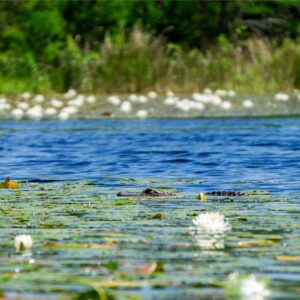
Photo: American Alligator (Alligator mississippiensis) Jocelyn Painter, NCWF Photo Contest Submission
In 2023, the U.S. Supreme Court issued a decision in Sackett v. EPA that drastically limited Clean Water Act protections for the nation’s wetlands against unfettered development. In the aftermath of that decision, anti-regulation activists are testing the bounds of the court’s decision with targeted lawsuits, hoping to further restrict the federal protections that remain. In eastern North Carolina, an individual who owns numerous tracts of wetlands-rich land along the banks of the Pasquotank River and Big Flatty Creek built several bulkheads and filled in many acres of wetlands behind them. The United States government brought an enforcement action against him, seeking to impose penalties for the filling of those wetlands that were still protected under the Clean Water Act. The National Wildlife Federation (NWF) and NCWF, represented by the Southern Environmental Law Center (SELC), filed an amicus or “friend of the court” brief in that case, arguing that federal wetlands protections should not be further limited and that obtaining a state coastal development permit did not give the landowner a free pass to destroy federally protected wetlands. “What the plaintiff in this case is seeking could make it more difficult to protect wetlands and other waters that are critical to fish, waterfowl, shellfish, and other wildlife, and allow widespread destruction and degradation of those critically important waters along with pollution and flooding downstream,” said Manley Fuller, NCWF Vice President of Conservation Policy. “Strong Clean Water Act protections safeguard critical wetlands and other waters that sustain our nation’s wildlife and people.”
In addition, NWF and NCWF intervened in court when the same landowner, represented by the same anti-regulation organization that represented the Sacketts in the Supreme Court case, filed a separate lawsuit challenging the current limits on development in wetlands. Again represented by SELC, NWF and NCWF are participating in the case as a voice against further restrictions on wetlands protections. The landowner, represented by Pacific Legal Foundation, sought an injunction, asking the court to prohibit the US Environmental Protection Agency and Army Corps of Engineers from enforcing even the very narrow definition of protected wetlands articulated by the Sackett court. After arguing that the landowner’s interpretation went beyond what the Supreme Court held in Sackett, NWF and NCWF have already received favorable decisions in this case. In three separate decisions, federal courts agreed with our position and denied the landowner’s request to enjoin the agencies from applying their interpretation of the Sackett decision, pending the final outcome of the litigation. We have now finished briefing the case on the merits and expect a final ruling in the next few months. A ruling in the landowner’s favor could remove federal protections from most wetlands with potentially devastating effects on waters throughout North Carolina and the nation. NWF and NCWF are prepared to oppose that result and to protect wildlife habitat in wetlands every step of the way.
“We have been involved in water and wetlands work for many years and engaged in litigation and policy work when attacks on bedrock rules protecting these resources have occurred,” says Fuller. “Folks who love our streams, rivers, and wetlands deserve better, which is why we are fighting for strong, clear, science-based national clean water protections in court.”
Wildlife Crossings
Wildlife in North Carolina continues to survive and thrive despite the challenge of navigating 80,000 miles of state-maintained highways. Roads cut across the landscape where species like the American black bear, white-tailed deer, and many others attempt to cross, putting both animals and motorists at risk.
The presence of roads significantly impacts both plants and animals. In addition to the immediate threat of roadkill, animals near roadways face disturbances from noise, light, and air pollution. Highways also pose more subtle, long-term threats that can harm entire species. To address this, NCWF is working on solutions, including the creation of wildlife crossings that allow animals to safely navigate roads that would otherwise lead to their demise.
For years, NCWF has been focused on developing wildlife passage infrastructure that links essential habitats across North Carolina. This includes supporting the state’s application for federal funding from the NCDOT and NCWRC for a major wildlife crossing and fencing project along U.S. 64 in the Alligator River National Wildlife Refuge, an area where wildlife-vehicle collisions, including those involving Red Wolves, black bears, and deer, have been particularly frequent.
In addition to advocating for this federal grant, NCWF is also collaborating with state and federal agencies to ensure safer road construction following the destruction caused by Hurricane Helene in western North Carolina. This includes pushing for wildlife-friendly rebuilding efforts, such as wildlife passage systems associated with new bridges, wildlife fencing, and upgraded culverts. These measures will not only improve safety for motorists but also help reduce wildlife mortality.
Habitat
“We already are actively managing nearly all of our privately owned lands and much of the public spaces in the United States. We simply need to include ecological function in our management plans to keep the Sixth Great Extinction at bay.” – Douglas W. Tallamy, Nature’s Best Hope
Effective wildlife conservation requires a thoughtful, proactive, and nuanced approach to habitat management and restoration. No part of North Carolina’s landscape has remained entirely untouched by human activity, though the extent of that impact varies. Some habitats may appear much as they did centuries ago, before European settlement, while others have been significantly altered by rapid urbanization, suburban expansion, and other forms of development. These changes bring challenges such as pollution, habitat degradation, invasive species, and more—all contributing to the decline of native ecological communities. Despite these challenges, some wildlife continues to thrive in these altered environments, but protecting, conserving, and restoring them demands intentional management and active engagement.
Restoring and nurturing habitats to support wildlife requires both private and public land management strategies that prioritize ecological health. NCWF leads these efforts in North Carolina through policy advocacy and a robust network of Community Wildlife Chapter volunteers. This work has become especially crucial in the aftermath of Hurricane Helene and the destruction it caused, particularly in the western part of the state.
Community Wildlife Chapter Habitat Restoration Impact
NCWF’s volunteer programs have had a significant impact this year, with 9,500 volunteers actively engaged in conservation efforts, particularly habitat restoration events. This incredible increase in volunteer engagement comes as a result of our growing Outreach Team, who are able to facilitate more projects with higher impact throughout the state, and through the generosity of our donors and community partners.
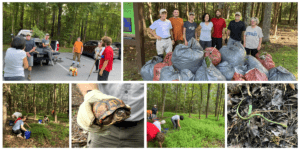
September 20, Merchants Millpond State Park Invasive Species Removal: NCWF Wildlife Habitat Stewards of Northeastern NC Chapter partnered with Merchants Millpond State Park and community volunteers to remove invasive Japanese stiltgrass from the park’s Coleman Trail. In 2 hours, volunteers were able to remove around 660 lbs of stiltgrass. In October, the chapter and volunteers will come back together to plant native grasses at the site!
- Removing litter from wildlife habitats helps protect animals from potential harm, such as ingestion or entanglement in plastic and other debris. Clean environments support the health of ecosystems by maintaining the balance of plant and animal life. It also prevents pollution from contaminating water sources and soil, which can poison species or disrupt food chains. By reducing litter, we ensure that habitats remain suitable for wildlife to thrive, promoting biodiversity and ecological stability.
NCWF Community Wildlife Chapters safeguarded stream and maritime ecosystems’ aquatic and terrestrial wildlife by removing 153,000 pounds of litter from the environment (this includes 40 tons of litter removed through post-Hurricane Helene cleanup at Lake Norman), compared to last year’s 115,785 pounds of litter, demonstrating a 32.1% increase.
November 3, Butterfly Highway Pollinator Planting: NCWF Charlotte Wildlife Stewards Chapter installed a Pollinator Pitstop along the Butterfly Highway. This pollinator project was made possible by funds raised from Wild on the Water, CWS’s annual fundraiser for wildlife. Ten enthusiastic volunteers showed up to plant 89 plants representing 13 plant genera and 15 species! Plants such as milkweed, aster, cardinal flower, and blue-eyed grass will provide valuable food for native pollinators. Species such as mountain mint, bee balm, and muhly grass will also provide cover and places for pollinators to raise young.
- Planting native plants enhances wildlife habitats by providing food, shelter, and nesting sites tailored to the needs of local species. Native plants support biodiversity by attracting and sustaining pollinators, birds, and other wildlife that rely on them for survival. They help maintain ecological balance by stabilizing soil, conserving water, and reducing the spread of invasive species that can threaten local ecosystems. Overall, native plants promote a healthier, more resilient environment that supports the long-term well-being of wildlife.
NCWF Community Wildlife Chapters created thriving ecosystems for native pollinators and songbirds with the planting of 23,220 native trees and plants giving goldfinches, red-cockaded woodpeckers, butterflies and bees places to feed and nest compared to last year’s 5,323, demonstrating a 336.5% increase.
September 29th, Invasive Removal Workday at Occoneechee Speedway with TCC: NCWF Tri-County Conservationists Chapter held an invasive plant removal workday at the Occoneechee Speedway Trail in Hillsborough, NC. Volunteers helped remove a thick line of Chinese privet, English ivy, and autumn olive from a stretch along the trail. This brave group of tree rescuers took down lots of tall privet and an autumn olive tree that was 15 feet tall!
- Removing invasive plant species restores the health of wildlife habitats by preventing these non-native plants from outcompeting native vegetation. Invasive species can disrupt food sources and disrupt the natural balance, harming the animals that depend on native plants for shelter, food, and breeding. By removing invasive plants, we allow native plants to thrive, which in turn supports local wildlife, enhances biodiversity, and helps maintain ecosystem stability. This process improves soil health, water quality, and overall habitat resilience.
NCWF Community Wildlife Chapters increased biodiversity by removing invasive species from 19 acres of land benefitting birds, pollinators, and many other wildlife and plants.
The significant 336.5% boost in native planting numbers can be attributed to the Atlantic white cedar planting project at Millennium Forest, located within the Pocosin Lakes National Wildlife Refuge – benefiting species such as birds, Hessel’s hairstreak butterflies, white-tailed deer, and other small mammals. This initiative, a key part of our partnership with the refuge and the US Fish & Wildlife Service’s Coastal Program, stands out not only for its scale but also for the opportunity it presents to monitor the survival of the trees post-planting, providing valuable data for future restoration efforts. While most of our habitat restoration projects are focused on urban and suburban areas, where wildlife habitats are most at risk due to development and land use changes, the Atlantic white cedar planting on a protected Wildlife Refuge offers a unique chance to restore an important native species in a more controlled environment.
Additionally, as of this year, community members across the state have registered 3,600 Pollinator Pitstops on NCWF’s Butterfly Highway and registered 5,038 Certified Wildlife Habitats.
These efforts reflect the ongoing dedication of volunteers to support wildlife conservation in North Carolina.
Hurricane Helene Impact and Restoration Efforts
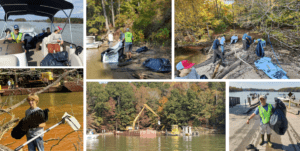
Following the devastating effects of Hurricane Helene, NCWF coordinated four large-scale cleanup events along the Catawba River, stretching from Lake James to Lake Norman. These efforts resulted in the collection of approximately 40 tons of debris, helping restore vital river ecosystems and support local wildlife. Though these efforts are still underway and the end is not yet in sight, NCWF is dedicated to being an active participant in the restoration of these impacted areas – both for wildlife and people alike.
Old Growth Forests and Wildlife Habitat Conservation
Old-growth forests remain a top priority for NCWF, as they provide crucial habitats for species such as the brown-headed nuthatch and other key species.
In August, NCWF Vice President of Conservation Policy, Manley Fuller, voiced support for the U.S. Forest Service’s National Old Growth Amendment, which aims to protect and manage mature and old-growth forests for both people and wildlife. These forest ecosystems are vital for species like the Carolina northern flying squirrel, which depend on large trees for nesting sites. In addition to our advocacy for old-growth protection, NCWF is actively supporting restoration funding for the Pisgah and Nantahala National Forests, which were significantly impacted by Hurricane Helene. The storm caused severe damage to roads, trails, and trees, as well as increased the potential for wildfires and the spread of invasive species. Restoration work is ongoing, and we continue to support efforts to restore these areas and protect critical wildlife habitats.
Coastal Barrier Resources Act Expansion
The Coastal Barrier Resources Act (CBRA) was originally signed into law in 1982 to protect undeveloped coastal areas that act as natural buffers against storms and flooding. In North Carolina, 149,379 acres are currently included within 16 units of the CBRA System. This system helps protect valuable wildlife habitat and reduces the economic costs of storm damage. Recently, the passage of the Bolstering Ecosystems Against Coastal Harm (BEACH) Act expanded the CBRA by adding more than 280,000 acres to the system. NCWF and the National Wildlife Federation have long supported the expansion of the CBRA, which aids in storm protection, saves taxpayer dollars, and preserves important coastal habitats. We will continue to advocate for additional actions to protect and augment existing CBRA units where needed.
Landowner Tax Credit
With the vast majority of North Carolina being privately owned, private landowners have a great responsibility to care for the wildlife habitat on their own land. While there are many simple and cost-effective ways to care for wildlife on your property, there has been some historical difficulty for private landowners to manage their land with wildlife in mind.
However, after a 10-year hiatus, the North Carolina Conservation Tax Credit has been reinstated and passed the legislature with unanimous approval. This credit provides an additional incentive for private landowners to pursue conservation options for their properties.
People
“There’s a long-standing maxim in conservation circles: people support what they love, and they love what they know.” – Greg Peters, Our National Forests
NCWF is a dedicated wildlife organization, and our core mission revolves entirely around the protection, conservation, and restoration of wildlife. However, our work cannot be achieved in isolation—it relies on the commitment, energy, and passion of people. People are the driving force behind everything we do. As highlighted in our habitat efforts, our network of volunteer conservationists within the Community Wildlife Chapters plays a crucial role in hands-on habitat restoration. Yet, our impact extends far beyond this through our collaborative efforts with the broader conservation community, particularly through our education and wildlife training programs.
These programs are central to empowering individuals with the knowledge and skills needed to contribute effectively to wildlife conservation in their own yards and communities. By educating and training the next generation of conservation leaders, we foster a network of informed, engaged citizens who are better equipped to advocate for and protect wildlife. In 2024, these programs had a profound influence on the conservation community throughout North Carolina. From training volunteers in effective habitat management to providing resources for local landowners and communities, our educational initiatives are creating tangible, lasting change. By strengthening the connection between people and the natural world, we’re building a more resilient, sustainable future for wildlife in North Carolina.
New NCWF Community Wildlife Chapter in Durham

Durham Wildlife Stewards
NCWF’s Community Wildlife Chapter network is ever-expanding, and the newest addition arrive this year through the NCWF Durham Wildlife Stewards Chapter in Durham, NC. The chapter will work to restore habitat and raise awareness around wildlife in the Durham area, alongside other chapters in the Research Triangle and beyond.
“The Durham Wildlife Stewards is excited to be working hard to become NCWF’s newest chapter!” Said Rah (Sarah) Bickley, DWS President, “So far we’re held a social gathering in Durham’s Central Park, helped the Eno River Association plant trees, talked with the public about native plants at the State Fair, broken ground on a new garden with the folks at the Salvation Army Boys & Girls Club of Durham, and helped stop a Durham development project that would have harmed Sandy Creek. We look forward to working with more Durham folks and organizations in 2025.”
Community Wildlife Chapter Nature Outings
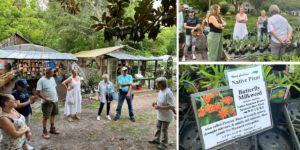
June 22, Shelton Farm Tour: NCWF’s Southeastern Swamp Stewards Chapter hosted a tour of Shelton Farm Nursery. The group learned about Shelton Farm’s history and their effort to promote native plants in Southeastern NC.
The most crucial step in fostering successful conservation and environmental change is giving people a reason to care about the natural world. This begins by connecting them to nature in meaningful ways. Through our wildlife and nature outings, we provide opportunities for individuals of all ages to immerse themselves in the outdoors and experience firsthand the beauty and significance of our natural surroundings. These outings are designed to not only engage participants but also to educate them on the importance of preserving these environments. In 2024, NCWF chapters hosted 50 nature outings, offering diverse, hands-on experiences that deepened participants’ understanding and appreciation for wildlife and the need for conservation. These outings help cultivate a sense of responsibility and connection, inspiring action toward protecting the ecosystems that sustain us all.
Community Wildlife Chapter Educational Opportunities
Conservation efforts cannot end with simply spending time outdoors. That’s why NCWF goes a step further by offering educational presentations and webinars that deepen participants’ understanding of wildlife issues and conservation strategies. Over the past year, these educational opportunities covered a wide range of topics, including raptor rehabilitation, lead exposure in wildlife, mammals of the Piedmont region, transportation policy and its impact on wildlife, the effects of wildfires, North Carolina’s environmental history, migratory species, insects, coyotes, and much more. These presentations offer valuable insights into the challenges facing wildlife in our state and provide actionable steps that individuals can take to make a difference.
In total, NCWF hosted 110 in-person, lecture-style wildlife presentations and 30 online or virtual wildlife events. Many of these presentations are available for ongoing reference and learning on our YouTube channel, ensuring that the information continues to reach and inspire audiences long after the events have ended. These educational resources are key to empowering individuals to become active participants in wildlife conservation and to foster a deeper connection with the natural world around them.
Youth and Family Engagement
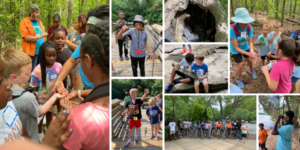 One of the most vital aspects of NCWF’s nature and wildlife engagement efforts is the process of nurturing and preparing the next generation of wildlife conservationists. This is accomplished through a variety of initiatives, including our youth programs and academic scholarship opportunities.
One of the most vital aspects of NCWF’s nature and wildlife engagement efforts is the process of nurturing and preparing the next generation of wildlife conservationists. This is accomplished through a variety of initiatives, including our youth programs and academic scholarship opportunities.
Through NCWF’s youth programming, we introduce thousands of young people to the wonders of the outdoors, sparking their interest and passion for wildlife through hands-on, exciting activities, field outings, and educational experiences. In 2024, NCWF connected with 4,700 youth, offering them opportunities for growth and learning through Kids In Nature Days open and free to the public, ecoEXPLORE programming in partnership with community libraries in northeastern NC, 2,792 day trips and 9 Great Outdoors Univeristy (GoU) events on nature walks and natural scavenger hunts, 122 GoU day trips with educational programming and lessons about wildlife importance and function in the ecosystem. These experiences not only inspire a love for nature but also equip the next generation with the knowledge and skills to become active stewards of the environment, ensuring that the future of wildlife conservation remains in capable hands.
NCWF 2024 Scholarships
For more than 50 years, NCWF has provided tens of thousands in scholarship funds to more than 500 students conducting research and pursuing careers in wildlife conservation related areas. In 2024, we were proud to award scholarships to seven deserving students, with amounts ranging from $1,500 to $2,500. These scholarships provide valuable support to students pursuing studies in wildlife conservation, environmental science, and related fields, helping to foster the next generation of conservation leaders. Among the recipients were Sweta Dixit of NC State, who received the Alamance Wildlife Club Sponsored Grant for her work in dimensions of wildlife conservation, with a focus on promoting human-wildlife coexistence. Lauren Pharr of NC State received the Conservation Leadership Grant for her work in avian conservation and the longleaf pine ecosystem.
By investing in the education of these young individuals, we are contributing to a future where wildlife and natural habitats continue to be protected and preserved for years to come.
Red Wolf Center and Live Cams
A key focus of NCWF’s conservation efforts is the Red Wolf, the world’s most endangered canid, which now exists solely in North Carolina. One of the ways NCWF supports the recovery of this species is by operating the Red Wolf Center. Despite being closed for three months for renovations to both the center and the Red Wolf acclimation pens, the Red Wolf Center hosted 634 visitors and offered 280 programs in 2024. These programs are vital for educating the public about the Red Wolf’s plight and the ongoing efforts to restore this species to the wild, making the center an essential resource for raising awareness and fostering support for Red Wolf conservation.
The Red Wolf Live Cams were featured for two days on the Earth Cam website homepage due to their popularity! Collectively, the live cameras in the enclosure and in the den received nearly 540,000 views.
Additionally, the Heron Live Cam and the Osprey Live Cam on Lake Norman received 10,842 views and 149,113 views, respectively. These numbers are lower than usual as a result of technical difficulties with the live cam, which will be remedied this coming year.
Hunting Education
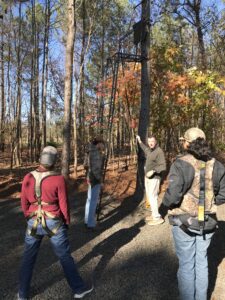 NCWF recognizes hunting as a valuable conservation tool that plays a vital role in species management. In the absence of historically present apex predators on the landscape, hunting plays a role in population control, ensuring genetic health, and in preserving otherwise over-foraged landscapes as a result of high population densities in small geographic areas. Hunting also plays a big part in encouraging public involvement in hands-on, hunter led conservation efforts. Through a variety of educational initiatives, NCWF provides both in-person workshops and webinars to support hunters and promote responsible hunting practices. Events like NCWF Gaston PAWS Chapter workshops featured sessions on turkey hunting (with 16 attendees), squirrel hunting (9 attendees), and deer hunting (28 attendees). Additionally, NCWF reached a wider audience through online webinars, including the Deer Hunting Webinar, which attracted 175 participants, and the Deer Processing Webinar, with 186 registrants, including those who viewed the recorded sessions. These programs are designed to equip hunters with the essential knowledge and skills needed to practice sustainable hunting while contributing to broader conservation goals.
NCWF recognizes hunting as a valuable conservation tool that plays a vital role in species management. In the absence of historically present apex predators on the landscape, hunting plays a role in population control, ensuring genetic health, and in preserving otherwise over-foraged landscapes as a result of high population densities in small geographic areas. Hunting also plays a big part in encouraging public involvement in hands-on, hunter led conservation efforts. Through a variety of educational initiatives, NCWF provides both in-person workshops and webinars to support hunters and promote responsible hunting practices. Events like NCWF Gaston PAWS Chapter workshops featured sessions on turkey hunting (with 16 attendees), squirrel hunting (9 attendees), and deer hunting (28 attendees). Additionally, NCWF reached a wider audience through online webinars, including the Deer Hunting Webinar, which attracted 175 participants, and the Deer Processing Webinar, with 186 registrants, including those who viewed the recorded sessions. These programs are designed to equip hunters with the essential knowledge and skills needed to practice sustainable hunting while contributing to broader conservation goals.
NCWF 2024 Photo Contest
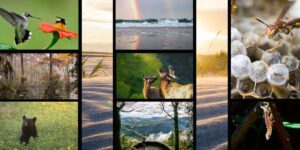 In addition to our educational efforts and hands-on engagement, NCWF believes it is essential to continue celebrating the beauty of wildlife and the outdoors—and honoring those who help highlight it through their own work. This year, NCWF hosted the 6th Annual Wildlife Photo Contest, which received over 1,000 submissions from professional, amateur, and youth photographers, showcasing the diverse wildlife and habitats of North Carolina, from the coast to the mountains. The contest featured categories such as Critters, People in Nature, Scenes of North Carolina, and Pollinators. All entries were anonymously judged by a panel of 15 experts, who selected this year’s winners and honorable mentions, celebrating the talent and passion of those who capture the essence of our natural world.
In addition to our educational efforts and hands-on engagement, NCWF believes it is essential to continue celebrating the beauty of wildlife and the outdoors—and honoring those who help highlight it through their own work. This year, NCWF hosted the 6th Annual Wildlife Photo Contest, which received over 1,000 submissions from professional, amateur, and youth photographers, showcasing the diverse wildlife and habitats of North Carolina, from the coast to the mountains. The contest featured categories such as Critters, People in Nature, Scenes of North Carolina, and Pollinators. All entries were anonymously judged by a panel of 15 experts, who selected this year’s winners and honorable mentions, celebrating the talent and passion of those who capture the essence of our natural world.
Written by:
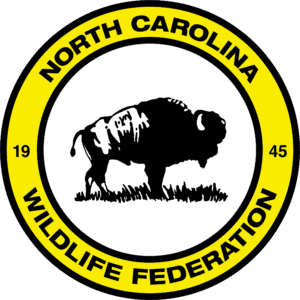
– NCWF Staff
Organized by:

– Bates Whitaker, NCWF Communications & Marketing Manager


